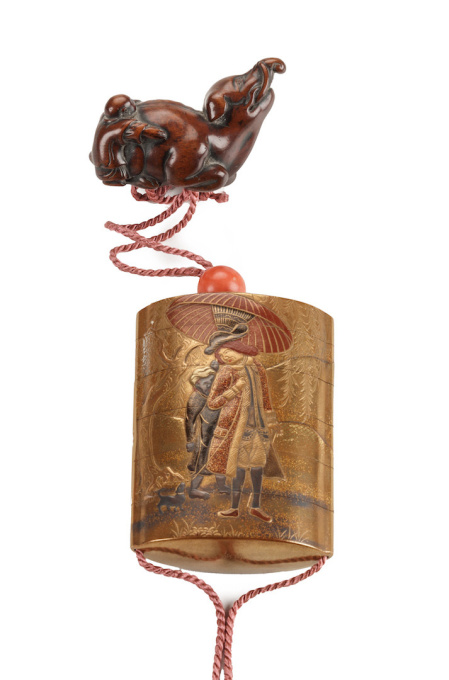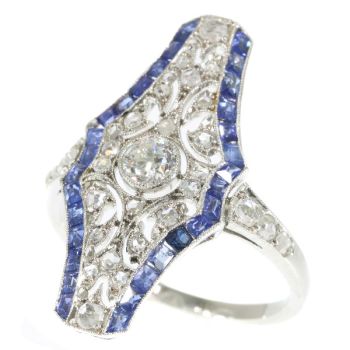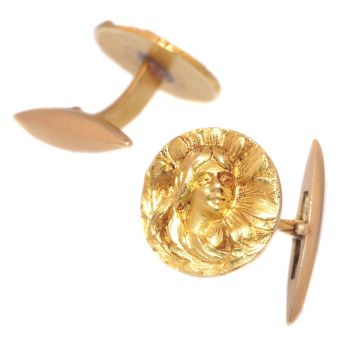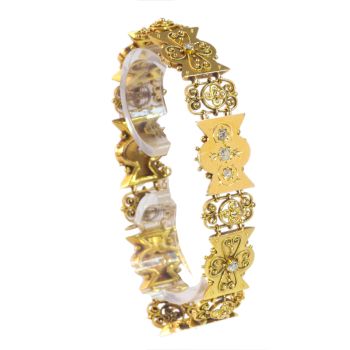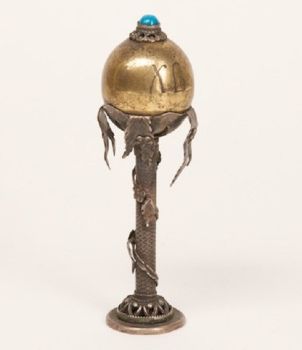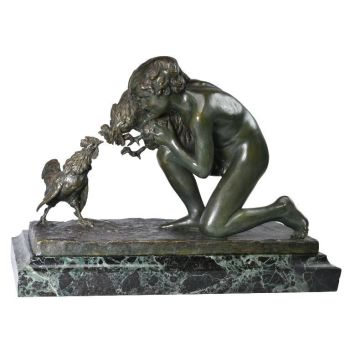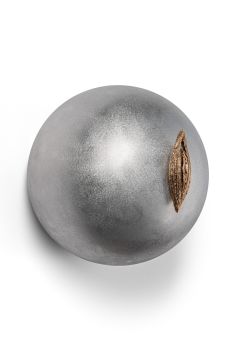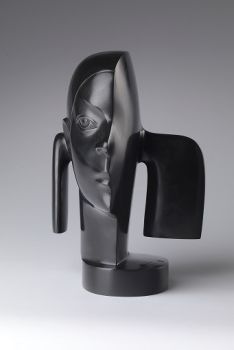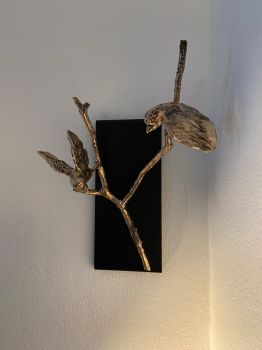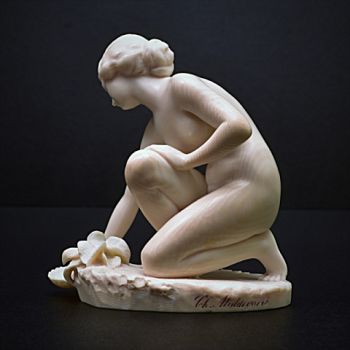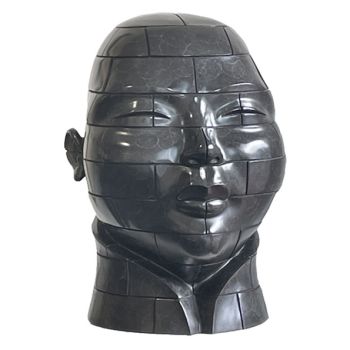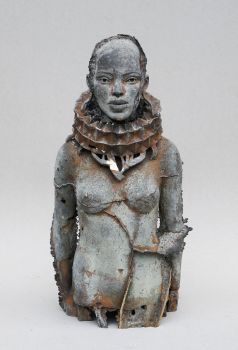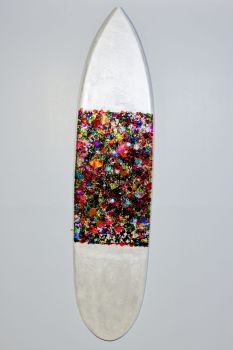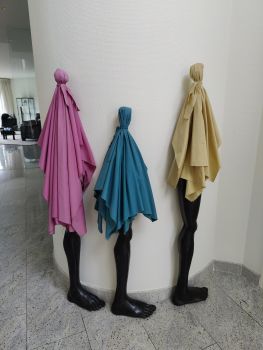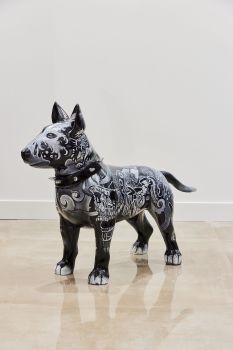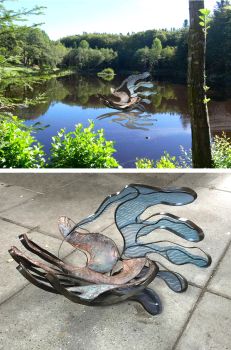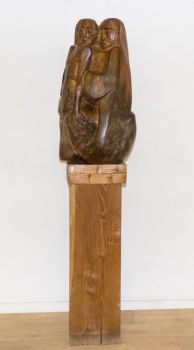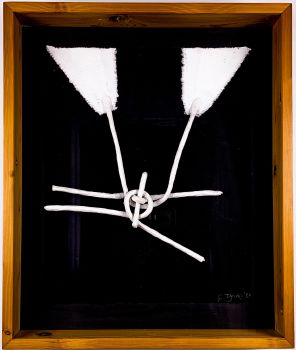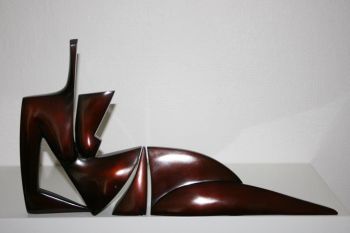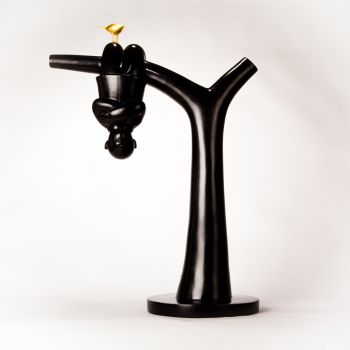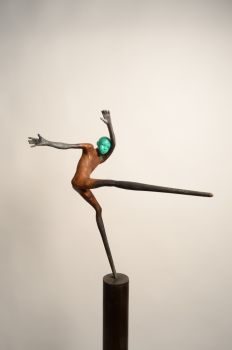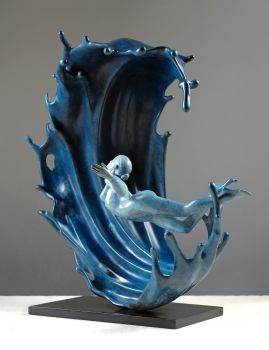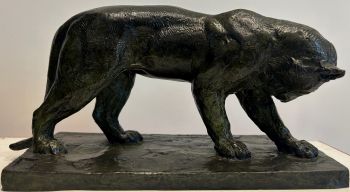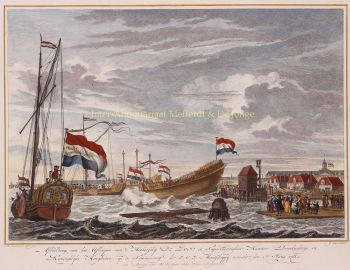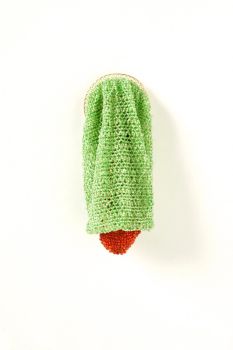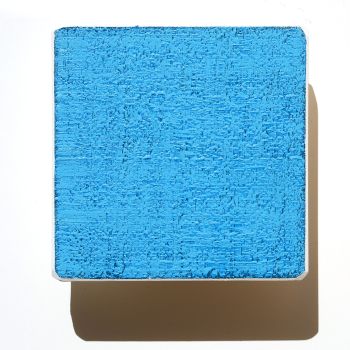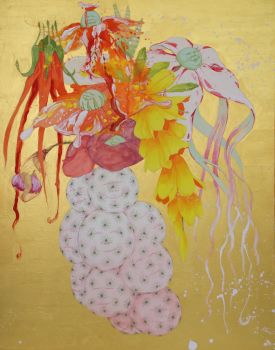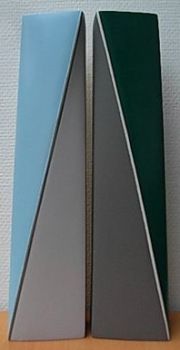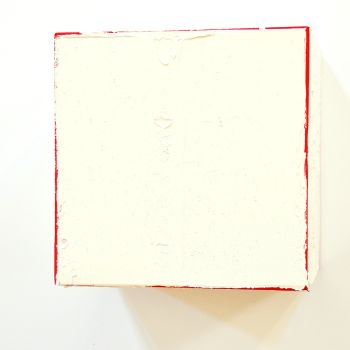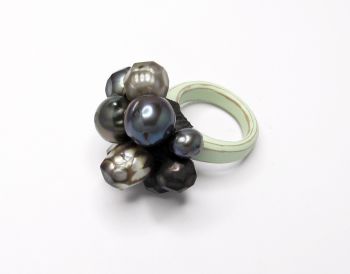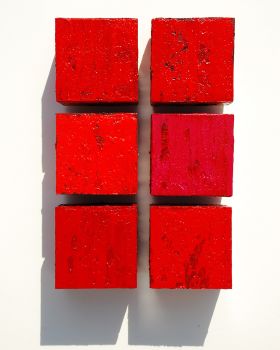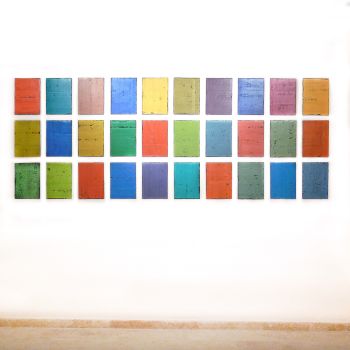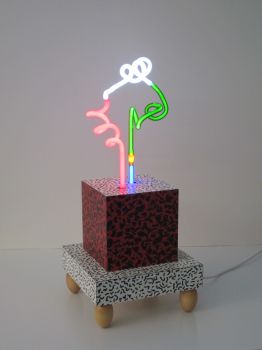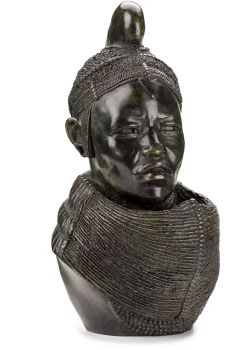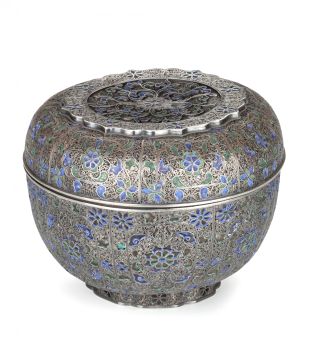Inro fine del XVIII secolo, netsuke metà del XVIII secolo 1850 - 1900
Artista Sconosciuto
LegnaOroArgento
Attualmente non disponibile tramite Gallerease
Zebregs & Röell - Fine Art - Antiques
- A proposito di opere d'arteINRO, OJIME AND BAKU NETSUKE SIGNED KOMA KORYU (DIED BEFORE 1789)
Inro late 18th century, netsuke mid 18th century
Gold lacquered six-compartment inro, decorated in gold and silver hiramaki-e and takamaki-e and with red lacquer, on one side with a Dutchman, his dog and a Javanese servant holding a sunshade, on the other side a Dutch ship with black sails, the inside of the compartments decorated with nashiji, the netsuke, in the form of an elephant and a boy trying to climb onto it, cedarwood.
Inro H. 9 x W. 6.3 cm
Netsuke L. 6 cm
Provenance:
The Frits Philips Collection
Note:
Koryũ family name was Kimura, but this was changed to Koma on his adoption by his brother-in-law Koma KyühakuIII, whose pupil he became. Koma Koryũ was a pivotal figure in the later Koma school, absorbing the skills of his distinguished teacher and passing them on to Kansai I. His pupils also included Omura Gyokuzan and Nomura Kyüho. Koryũ was an inro specialist, but some other artefacts by him are recorded as well.
The decoration of the inro is most likely taken from an early Nagasaki woodblock print of a Dutchman and his servant holding a sunshade, possibly one published by Hariya in the mid 18th century. Since the Dutch, having pockets in their coats and trousers, did not use inro, this inro most likely was not made for export but to satisfy the Japanese fascination for the exotic foreigners. Unlike netsuke of Dutchmen, inro depicting Dutchmen are not common ( for a few examples see A Collection of Nagasaki Colour Prints and Paintings by N.H.N. Mody, plate. 218). The netsuke of the elephant, an animal introduced by the Dutch into Japan, could also be an example of the Japanese fascination with the exotic. - A proposito di opere artista
Può succedere che un artista o un creatore sia sconosciuto.
Alcune opere non sono determinate da chi sono state realizzate o sono state realizzate da (un gruppo di) artigiani. Esempi sono statue dell'antichità, mobili, specchi o firme non chiare o leggibili ma anche alcune opere non sono affatto firmate.
Inoltre puoi trovare la seguente descrizione:
•"Attribuito a …." A loro avviso probabilmente opera dell'artista, almeno in parte
•“Studio di ….” o “Officina di” A loro avviso un'opera eseguita nello studio o nella bottega dell'artista, eventualmente sotto la sua supervisione
•“Cerchio di…” A loro avviso un'opera del periodo dell'artista che mostra la sua influenza, strettamente legata all'artista ma non necessariamente al suo allievo
•"Stile di..." o "Seguace di..." A loro avviso un'opera eseguita nello stile dell'artista ma non necessariamente da un allievo; può essere contemporaneo o quasi contemporaneo
•“Modalità di…” A loro avviso un'opera nello stile dell'artista ma di epoca successiva
•"Dopo …." A loro avviso una copia (di qualsiasi data) di un'opera dell'artista
•“Firmato…”, “Datato…” o “Iscritto” A loro avviso l'opera è stata firmata/datata/inscritta dall'artista. L'aggiunta di un punto interrogativo indica un elemento di dubbio
•"Con firma....", "Con data...", "Con iscrizione..." o “Riporta firma/data/iscrizione” a loro avviso la firma/data/iscrizione è stata aggiunta da qualcuno diverso dall'artista
Sei interessato ad acquistare questa opera d'arte?
Artwork details
Related artworks
Artista Sconosciuto
Uovo di Pasqua di presentazione russo d'argento1880 - 1899
Prezzo su richiestaH.W.C. Dullaert Art & Antiques Dealer
1 - 4 / 12Artista Sconosciuto
UN NETSUKE MARINO IN AVORIO DI UN OLANDESE CHE TIENE UN FAN . CINESE18th century
Prezzo su richiestaZebregs & Röell - Fine Art - Antiques
Artista Sconosciuto
UN PICCOLO NETSUKE IN AVORIO DI UN OLANDESE CON UN TAMBURO1750 - 1800
Prezzo su richiestaZebregs & Röell - Fine Art - Antiques
Artista Sconosciuto
UN RARO GRANDE TELESCOPIO GIAPPONESE IN PELLE LACCATA1750 - 1800
Prezzo su richiestaZebregs & Röell - Fine Art - Antiques
Artista Sconosciuto
UN NETSUKE IN AVORIO DI UN OLANDESE CHE GIOCA CON UN RAGAZZINO18th century
Prezzo su richiestaZebregs & Röell - Fine Art - Antiques
Artista Sconosciuto
The Stamford Raffles Secretaires.1800 - 1813
Prezzo su richiestaZebregs & Röell - Fine Art - Antiques
Artista Sconosciuto
A rare Japanese export lacquer medical instrument box1650 - 1700
Prezzo su richiestaZebregs & Röell - Fine Art - Antiques
Artista Sconosciuto
COPPETTA CROGIOLO PICCOLA SAWASA GIAPPONESE 'FORMA PESCA'early 18th
Prezzo su richiestaZebregs & Röell - Fine Art - Antiques
Artista Sconosciuto
UN NETSUKE IN AVORIO DI UN OLANDESE CHE TIENE UN GALLETTO18th century
Prezzo su richiestaZebregs & Röell - Fine Art - Antiques
1 - 4 / 20Shinkichi Tajiri
“Koan” 1988 – papier-mâché / cotton on paper, original frame1988
Prezzo su richiestaVan Kerkhoff Art
Roger Godchaux
A bronze panther, with a nuanced green and textured patina.1950
Prezzo su richiestaMarco Boes Antiques
1 - 4 / 24Artista Sconosciuto
Olandesi in miniatura (Netsuke)1700 - 1900
Prezzo su richiestaZebregs & Röell - Fine Art - Antiques
Artista Sconosciuto
UN CONTENITORE PER DOCUMENTI DELLO SRI LANKA IN ARGENTO DORATO19th century
Prezzo su richiestaZebregs & Röell - Fine Art - Antiques
 A cura di
A cura diDanny Bree
Artista Sconosciuto
UN MODELLO GIAPPONESE DI UN NORIMONO, UN PALANQUIN1650 - 1700
Prezzo su richiestaZebregs & Röell - Fine Art - Antiques
Artista Sconosciuto
UN RARO SADELI INDIANO COMPLETO DI LAVORO E SCRITTURA INTARSIATI1800 - 1850
Prezzo su richiestaZebregs & Röell - Fine Art - Antiques
Artista Sconosciuto
UN INSOLITO PIATTO D'ARGENTO LOBBATO INDONESIlate 17th
Prezzo su richiestaZebregs & Röell - Fine Art - Antiques
Artista Sconosciuto
UN PICCOLO NETSUKE IN AVORIO DI UN OLANDESE CON UN TAMBURO1750 - 1800
Prezzo su richiestaZebregs & Röell - Fine Art - Antiques
1 - 4 / 24 A cura di
A cura diDanny Bree
Artista Sconosciuto
UN MODELLO GIAPPONESE DI UN NORIMONO, UN PALANQUIN1650 - 1700
Prezzo su richiestaZebregs & Röell - Fine Art - Antiques
Samuel Dejong
Anatomia Blue Heritage, Atlas Closed2017 - 2019
Prezzo su richiestaVilla del Arte Galleries
1 - 4 / 24Engelbert Kaempfer
IL LIBRO DI ENGELBERT KAEMPFER1651 - 1716
Prezzo su richiestaZebregs & Röell - Fine Art - Antiques
Artista Sconosciuto
UN NETSUKE MARINO IN AVORIO DI UN OLANDESE CHE TIENE UN FAN . CINESE18th century
Prezzo su richiestaZebregs & Röell - Fine Art - Antiques
Philip Reeves
A Massai/Rendille tribe girl from Kenya1952
Prezzo su richiestaZebregs & Röell - Fine Art - Antiques
1 - 4 / 12

